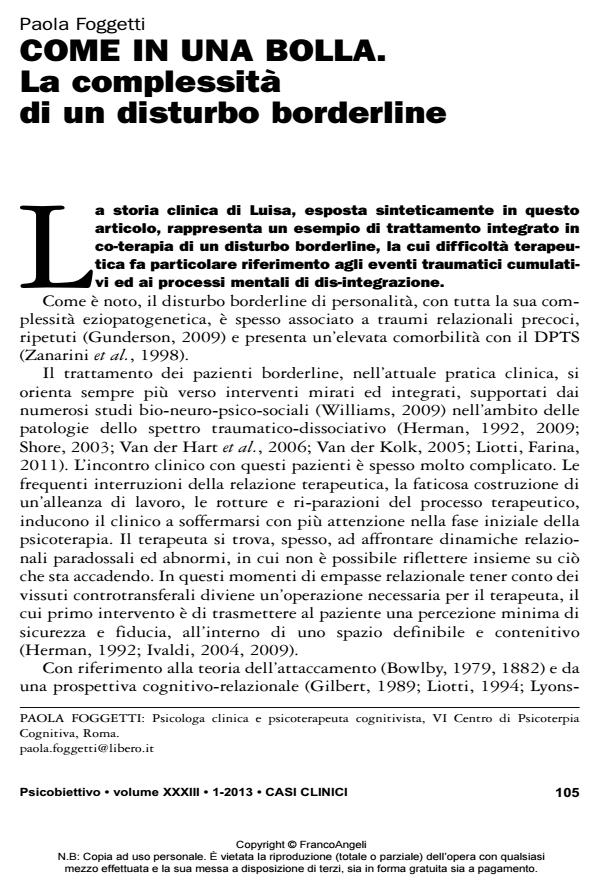Like living in a bubble. The complexity of a bordeline disorder
Journal title PSICOBIETTIVO
Author/s Paola Foggetti
Publishing Year 2013 Issue 2013/1
Language Italian Pages 14 P. 105-118 File size 248 KB
DOI 10.3280/PSOB2013-001008
DOI is like a bar code for intellectual property: to have more infomation
click here
Below, you can see the article first page
If you want to buy this article in PDF format, you can do it, following the instructions to buy download credits

FrancoAngeli is member of Publishers International Linking Association, Inc (PILA), a not-for-profit association which run the CrossRef service enabling links to and from online scholarly content.
With reference to recent studies on complex trauma and the traumatic-dissociative spectrum disorders, in this article we present the course of therapy of a borderline patient with dissociative symptoms of detachment and compartmentalization. Within an integrated cognitive-relational framework, particular emphasis is given to the initial therapeutic phases, in which the dynamics of disorganized attachment and the controlling strategies, strongly oppose the construction of a therapeutic context protective and cooperative.
Keywords: Complex Trauma; Disorganized Attachment; Controlling Strategies; Therapeutic Alliance
- Ivaldi A. (2009) Due stanze per la terapia: un trattamento ambulatoriale di psicoterapia integrata. Tra il modello cognitivo-evoluzionista e la psicoanalisi contemporanea, in Ivaldi A., Foggetti P., Aringolo K. (a cura di), Disturbi di personalità e relazione: giochi polifonici tra le parti. Linee di sviluppo e modelli di intervento, FrancoAngeli, Milano
- Lineahn M.M. (1993) Il trattamento cognitivo-comportamentale del disturbo borderline. Il modello dialettico, Raffaello Cortina, Milano
- Liotti G. (1994/2005) La dimensione interpersonale della coscienza, Carocci, Roma
- Liotti G., Farina B. (2011) Sviluppi traumatici. Eziopatogenesi, clinica e terapia della dimensione dissociativa, Raffaello Cortina, Milano
- Lyons-Ruth K., Jacobvitz D. (1999) La disorganizzazione dell’attaccamento: perdite non elaborate, violenza relazionale e cadute nelle strategie comportamentali e attentive, in Cassidy J., Shaker P.R. (a cura di), Manuale dell’attaccamento. Teoria, ricerca e applicazioni cliniche, Giovanni Fioriti, Roma
- Lyons-Ruth K., Jacobvitz D. (2008) Attachment disorganization: Genetic factors, parenting contexts, and developmental transformation from infancy to adulthood, in Cassidy J., Shaver P. (a cura di), Handbook of Attachment: Theory, Research and Clinical Application, Guilford Press, New York, pp. 666-697
- Main M., Hesse E. (1990) Parents’ unresolved traumatic experiences are related to infant disorganized attachment status: Is frightened/frightening parental behavior the linking mechanism?, in Greenberg M., Cichetti D., Cummings M. (a cura di), Attachment in the Preschool Years, University of Chicago Press, Chicago, pp. 121- 160
- Schore A.N. (2001a) “The effect of a secure attachment relationship on right brain development, affect regulation, and infant mental health”, Infant Mental Health Journal, 22: 7-66
- Schore A.N. (2001b) “The effect of relational trauma on right brain development, affect regulation, and infant mental health”, Infant Mental Health Journal, 22: 201-269
- Schore A.N. (2001c) The right brain as the neurobiological substratum of Freud’s dynamic unconscious, in Scharff D. (a cura di). The Psychoanalytic Century: Frued’s Legacy for the Future, The Other Press, New York, pp. 61-88
- Shore A.N. (2003b) La regolazione degli affetti e la riparazione del sé, Astrolabio, Roma
- Van der Hart O., Nijenhuis E.R.S., Steele K. (2006) Fantasmi del sé. Trauma e trattamento della dissociazione strutturale, Raffaello Cortina, Milano
- Van der Kolk B.A., McFarlane A.C. (1996) Il buco nero del trauma, in Van der Kolk B.A., McFarlane A.C., Weisaeth L. (a cura di), Stress traumatico. Gli effetti sulla mente, sul corpo e sulla società delle esperienze intollerabili, Magi, Roma, pp. 225-249
- Van der Kolk B.A. (2005) Il disturbo traumatico dello sviluppo: verso una diagnosi razionale per i bambini cronicamente traumatizzati (trad. it. In Caretti V., Craparo G. (a cura di), Trauma e Psicopatologia, Astrolabio, Roma, pp. 81-93)
- Williams R. (a cura di) (2009) Trauma e relazioni. Le prospettive scientifiche e cliniche contemporanee, Raffaello Cortina, Milano
- Zanarini M.C. et al. (1998) “Axis I comorbidity of borderline personality disorder”, American Journal of Psychiatry, 155: 1733-1739
- Bateman A., Fonagy P. (2004) Il trattamento basato sulla mentalizzazione. Psicoterapia con il paziente borderline, Raffaello Cortina, Milano
- Bowlby J. (1979) Costruzione e rottura dei legami affettivi, Raffaello Cortina, Milano
- Bowlby J. (1982) Attaccamento e perdita, vol. 1., Boringhieri, Torino
- Bowlby J. (1982) Attaccamento e perdita, vol. 2., Boringhieri, Torino
- Bromberg P.M. (2006) Destare il sognatore. Percorsi clinici, Raffaello Cortina, Milano
- De Bellis M.D. (2010) Neurobiologia della trascuratezza infantile, in Lanius-Ruth A., Vermetten E., Pain C. (a cura di), L’impatto del trauma infantile sulla salute e sulla malattia. L’epidemia nascosta, Giovanni Fioriti, Roma
- Di Maggio G., Semerari A. (2003), I disturbi di personalità. Modelli e trattamento, Laterza, Roma-Bari
- Gilbert P. (1989) Human nature and suffering, LEA, London
- Gunderson J.G. (2009) “Borderline Personality Disorder: Ontogeny of a diagnosis”, American Journal of Psychiatry, 166, 5: 530-539
- Fink G.R. et al. (1996) “Cerebral representation of one’s own past: Neural networks involved in autobiographical memory”, Journal of Neuroscience, 16: 4275-4282
- Herman J.L. (2009) Il disturbo post-traumatico da stress complesso, in Williams R. (a cura di), Trauma e Relazioni. Le prospettive scientifiche e cliniche contemporanee, Raffaello Cortina, Milano
- Herman J.L. (1992) Guarire dal trauma, Magi, Roma, 2005
- Ivaldi A. (2004) “Il triangolo drammatico: da strumento descrittivo a strumento terapeutico”, in Associazione di Psicologia Cognitiva (a cura di), Rivista Cognitivismo Clinico, I, 2, Giovanni Fioriti, Roma
Paola Foggetti, Come in una bolla. La complessità di un disturbo borderline in "PSICOBIETTIVO" 1/2013, pp 105-118, DOI: 10.3280/PSOB2013-001008